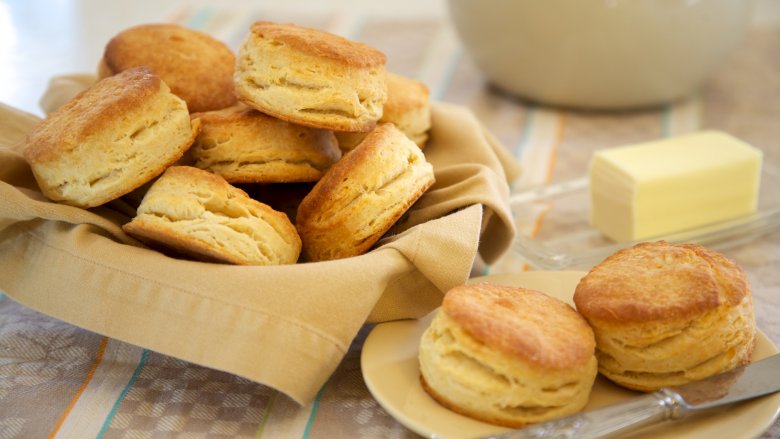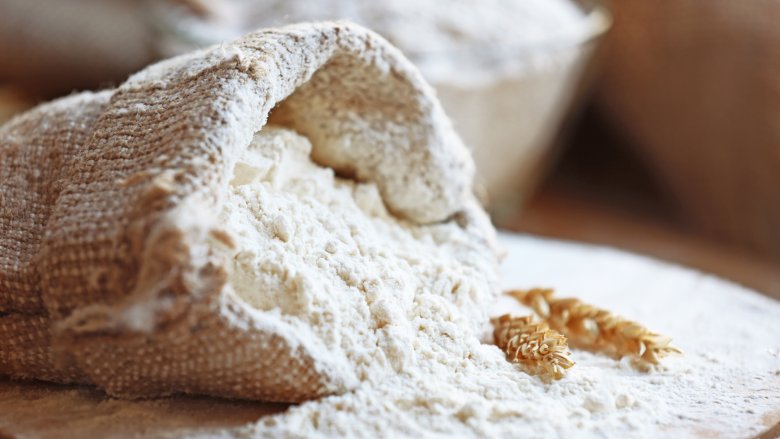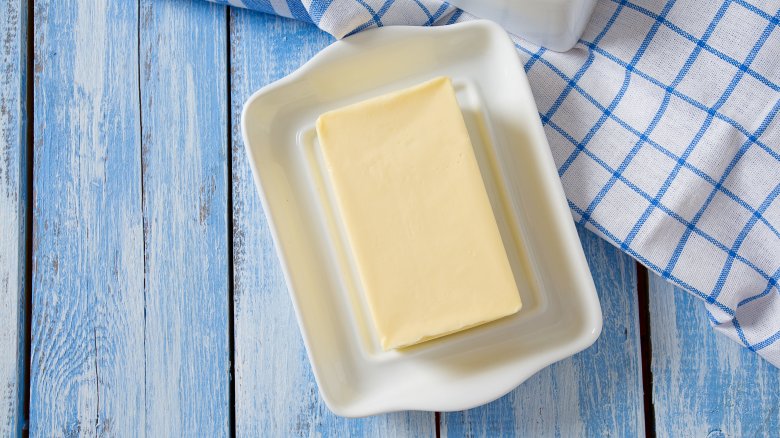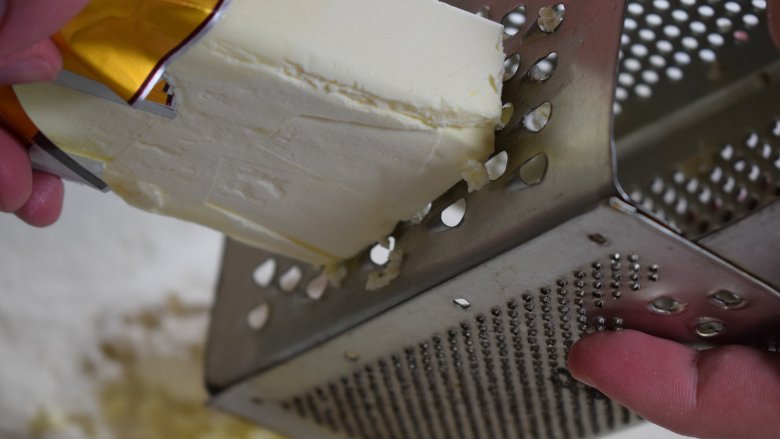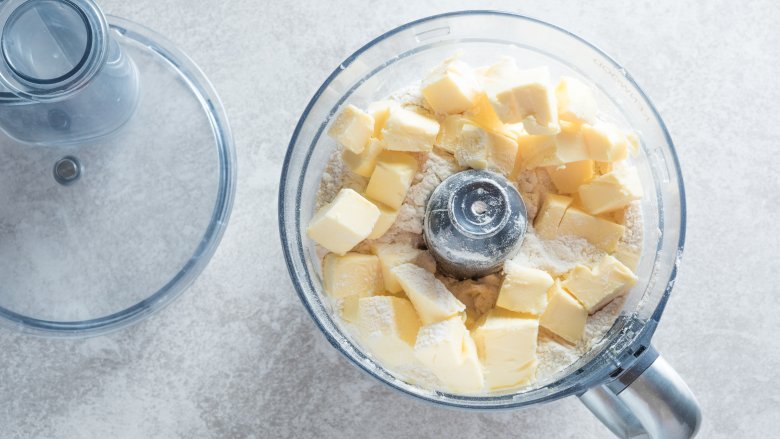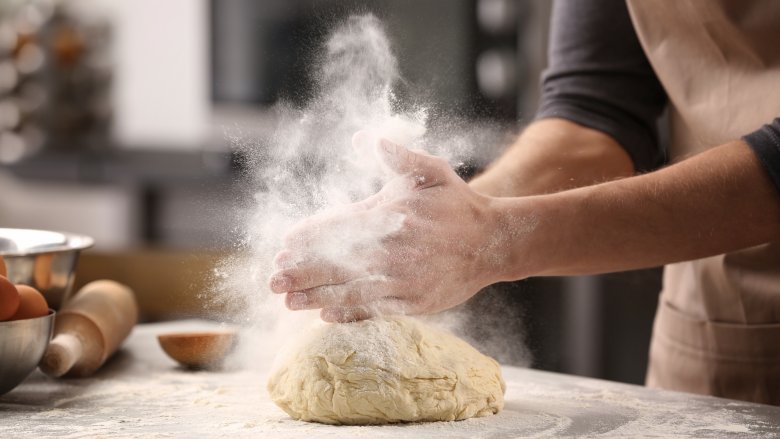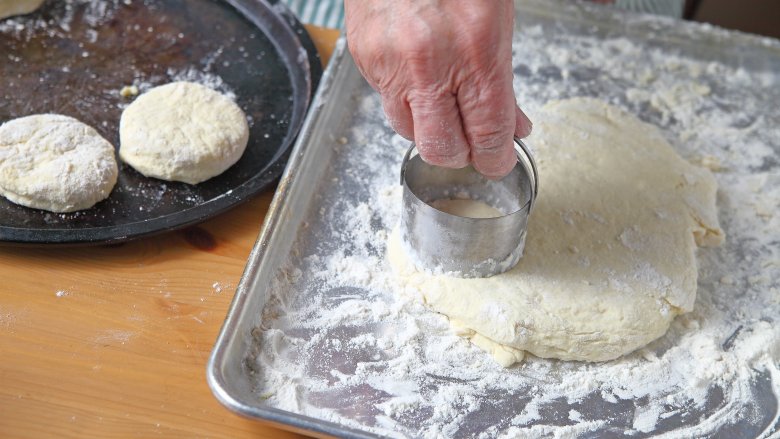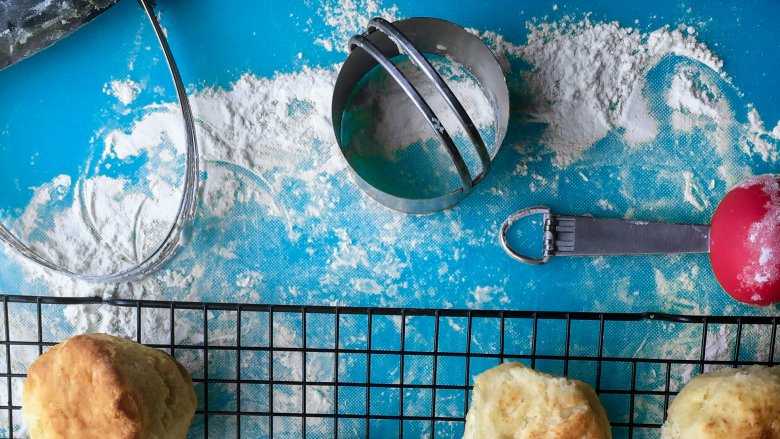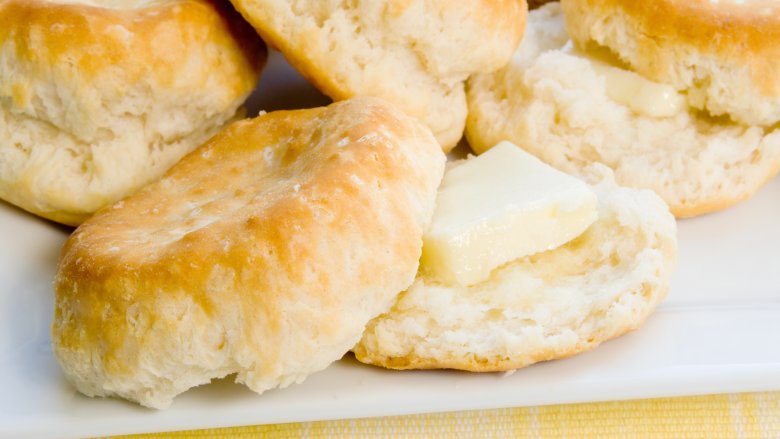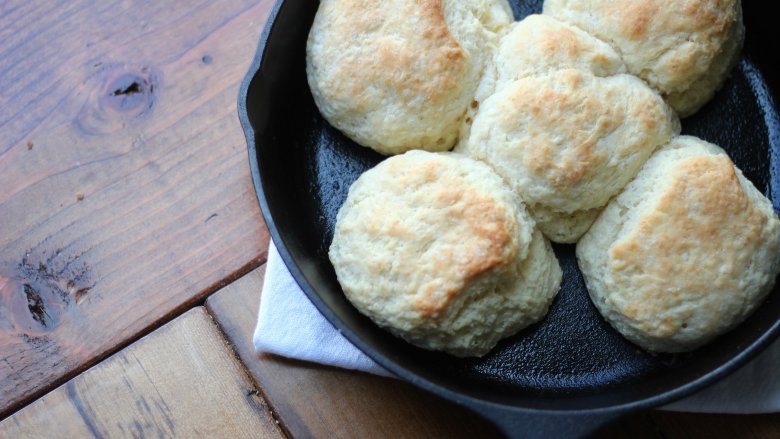The Secret That Makes Your Biscuits So Much Better
Pulling off a batch of decent buttermilk biscuits is something that even an amateur baker can manage. Unlike typical bread recipes, there's no yeast to worry about feeding, there's no proofing and rising to angst over, and there's no endless amount of kneading involved. And since most biscuit recipes list only a handful of ingredients, it seems like a foolproof endeavor.
While it is true that even the most basic recipe will yield perfectly passable results, it's the expert tips and tricks that really make a difference in producing the flakiest, most tender biscuits you ever sunk your teeth into. Did you know there's a "right" kind of flour to use? Did you know that your biscuit cutting technique might be doing more harm than good? And did you know that you should be using a box grater in your biscuit-making process? If you answered "no," "no," and "no," your biscuits might be suffering. But don't worry — these secrets to better biscuits will change everything.
The kind of flour matters
If you're like most casual bakers, you probably pick up the cheapest store-brand bag of flour when you wander down the baking aisle at the grocery store. All flour is created equal right? Allrecipes put that question to the test to determine just how much of a roll flour plays in the success of your biscuits, and it turns out flour matters more than you think.
With the brand of all-purpose flour being the only variable, six batches of biscuits were made. Although well-known favorites like Gold Medal and Bob's Red Mill were included in the test, it was White Lily, King Arthur, and Grist & Toll that produced the best results. Biscuits made with those brands were deemed to have a "fluffy, tender texture and outstanding flavor."
In fact, if you spend enough time browsing through biscuit recipes, you'll notice that aforementioned White Lily is cited much more often that other brands. But what is it about this particular flour that makes it a must-use ingredient? According to Southern Kitchen, White Lily, which is made from soft winter wheat, is low in protein. That's a very good thing when making biscuits, because it means that the gluten development is inhibited compared to brands like Gold Medal, and the result is a light, fluffy biscuit.
Keep things cold
If there's one tip that gets mentioned more than any other, it's that your butter must be cold, cold, cold. And if you want to take things a step further, you might as well throw your bowl of flour into the fridge, too, before you even begin your biscuit-making.
Cold ingredients, particularly the butter, is key to making better biscuits because it's what makes gives them that flaky texture you're aiming for. During the baking process, the intact bits of cold butter that are suspended in the flour are what create the layers of dough. When the fat is too warm it won't stay suspended, and according to King Arthur Flour creates a melted, homogenous dough that results in "dense, leaden biscuits."
To really ensure everything is cold enough, Southern Living recommends putting the mixture of butter and flour back into the refrigerator for 10 minutes before continuing with the recipe. Got that? Chill before. Chill after. The goal here is that when your biscuits go into the oven, that butter is still ice cold.
Use a box grater
Why in the world would you need a box grater to make biscuits? No, it's not for cheese, although cheesy biscuits don't sound so bad. It's actually for the butter.
Knowing just how important ice-cold butter is to the success of your biscuits, Southern Living recommends that rather than cutting the fat into the flour with a pastry cutter, you should use a box grater for the task. According to their test kitchen results, shredding frozen butter on the large holes of a grater means that the fat gets incorporated into the flour more evenly, and ultimately produces a better texture and flavor in your finished biscuits.
Just remember two things: When grating frozen butter, you'll need to work quickly so as not to warm it up in your hands. And those small shreds are going to melt more quickly than larger chunks, so chilling the butter and flour mixture when you're doing grating is an important step.
Use the right equipment
If pastry cutters or box graters aren't your thing when it comes making dough, you might be tempted to turn to an electric mixer to get the job done more quickly. Don't. Using a mixer is a good way to ensure that the fats will get too warm and the dough will be overworked, resulting in dense, heavy biscuits.
But there's got to be an easier way, right? That's where the food processor comes in. According to Cook's Illustrated, if you're not using a food processor to make your biscuits, you're doing it wrong. Why? For starters, a few pulses of the machine ensures that the dry ingredients are evenly incorporated. Next, the blade makes quick work of cutting the fat into the flour, which is key to keeping it cold. You will need to be patient though when adding the butter into the dry ingredients because adding it all at once will affect the texture of the dough. Pulse the fat into the flour in batches for the best results.
Skip the rolling pin
When it comes to biscuit-making, bakers generally fall into one of two camps: Those who think that it's perfectly acceptable to use a rolling pin, and those who do not. Sam Sifton, Food Editor of The New York Times, falls firmly into the latter camp. "Do not fool with a rolling pin. A rolling pin has no place in biscuits," he declares, not leaving much room for debate.
But why is the rolling pin so maligned? Sifton goes on to explain that biscuits "require a soft touch on the mixing, turning out and patting down of the dough." If you've ever wielded a rolling pin, you know that it's easy to manhandle the dough a little more than you meant to, and the more you work and roll, the tougher the biscuits are going to be. Aside from the potential of overworking, there's also the issue of the additional flour needed. Since you'll need to dust the dough and the rolling pin to ensure things don't stick, you run the risk of drying the dough out.
Bottom line: Don't be afraid to pat the dough out with your hands. It might not look picture perfect, but biscuits are supposed to be rustic, right?
The first roll is important
You've got your dough ready, and you're about to go to town with the biscuit cutter. But before you start haphazardly cutting out circles of dough in a random pattern, take a second to make a plan. Baker Carrie Morey tells Taste of the South that this is the best piece of advice she has to offer: "Make the most of your first roll-out of the biscuit dough, and stamp as many out as close together as possible, because the second roll is monumentally different in texture."
And don't even think about a third roll — you've got a firm two-roll limit here, no matter how much dough you have left. Yes, there will be scraps left over after that second roll, but all that extra handling and additional flour that will be needed to get one or two more biscuits just isn't worth it — one bite and they'd probably end up in the garbage anyway compared to the tender flaky first-roll batch.
The biscuit cutter matters
There's nothing more disappointing than pulling a batch of biscuits from the oven only to see sad, flat disks. You think you've done everything right: You used the right flour, you used ice-cold butter, and you didn't overwork the dough. So why aren't your biscuits rising to the occasion? The answer might lie in your biscuit cutter. Both the tool you choose and the technique you use when cutting out biscuits can affect how much they rise.
Reaching for a glass when you don't have a biscuit cutter seems like a sensible solution, but according to King Arthur Flour it's not the best choice. Rather than cutting through the dough cleanly, the dull edge of the glass will compress and seal the sides — not optimal when it comes to rising. If you don't have a biscuit cutter, use a very sharp knife instead. Square biscuits are infinitely better than squished biscuits.
And even if you are using a proper biscuit cutter, technique still matters. Be sure to push the tool straight down into the dough without twisting. Twisting will seal the sides (similar to using a glass), and prevent rising.
There's a trick to subbing in cream
Simple cream biscuit recipes with only two ingredients actually do exist, thanks to the use of (you guessed it) cream and self-rising flour. The cream provides not only the needed liquid but also the fat, and self-rising flour contains its own leavening agents. It's practically magic. But most biscuit recipes call for buttermilk, and buttermilk isn't something most of us have have hanging out in our refrigerators. So it stands to reason that if cream can be used in some biscuit recipes, in can be used in place of buttermilk in others, right? Wrong.
But due to the high fat content of cream, substituting it for buttermilk in a recipe that includes other fat, like butter or shortening, will result in a greasy biscuit. Southern Kitchen recommends that if you're going to skip the buttermilk, grab the milk instead — even whole milk is a better option. But if you're still hellbent on using that cream, at least opt for a recipe that doesn't have added fat.
Make the right choices when baking
Once you've perfected the making of biscuits, there's one more crucial step: The baking of said biscuits. What you bake them in matters, from the pan to the oven.
Cast iron is a good choice when it comes to baking biscuits because it holds heat so well, and can help the biscuits to cook faster. But if you don't have a cast iron pan you can still use a baking sheet, just make sure to keep the dough nestled together. Baker Carolyn Roy tells Taste of the South, "Don't spread out your biscuits on the baking sheet. It's best if they're actually touching each other. This will help to push them upward and give them some nice height."
No matter what pan you choose, your oven must be hot, hot, hot. Southern Living recommends setting the oven temperature to a whopping 475 degrees, which ensures that the biscuits rise and bake quickly. Cookbook author and chef Virginia Willis says that this high temperature is essential because "the steam interacts with the baking powder to create the biscuit's ideal textures inside and out."
